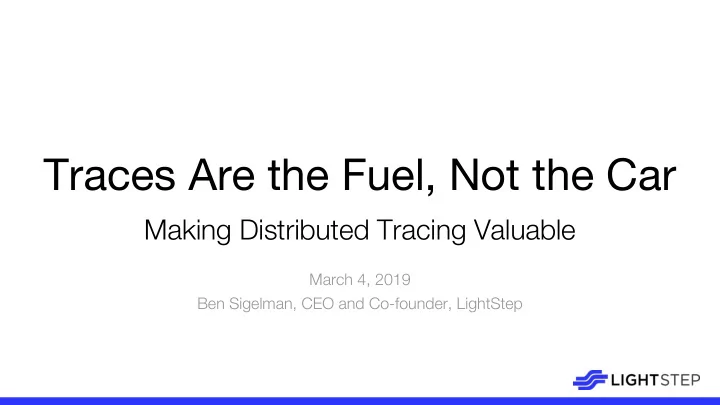

Traces Are the Fuel, Not the Car Making Distributed Tracing Valuable March 4, 2019 Ben Sigelman, CEO and Co-founder, LightStep
Part I Observability Dogma: A Critique
The Conventional Wisdom Observing microservices is hard Google and Facebook solved this (right???) They used Metrics, Logging, and Distributed Tracing … So we should, too.
Logs! Metrics! Traces! The Three Pillars of Observability
Fatal Flaws
So Many Flaws, So Little Time…
Fatal Flaws: “TL;DR” edition Logs Metrics Dist. Traces – ✓ ✓ TCO scales gracefully – ✓ ✓ Accounts for all data (i.e., unsampled) – ✓ ✓ Immune to cardinality
A fun game! Design your own (positive-ROI) observability system: High-throughput High-cardinality Unsampled Lengthy retention window Choose three.
Metrics, Logs, and Traces are Just Data , … not a feature or use case.
Logs! Metrics! Traces! The Three Pillars of Observability
Logs! Metrics! T r a c e s ! The Three Pillars Pipes of Observability
Part II Service-Centric Observability
A microservices architecture The WAN
A microservices architecture The WAN Consider a A narrow scope of single service... understanding = great! Faster releases, smaller teams, less friction, etc.
A microservices architecture (with a slowdown) The WAN A narrow scope of A narrow scope of A understanding = great! understanding = great! B C … problematic. D Decoupling cuts both ways. E
Hands-on with a single distributed trace
Distributed traces, in summary - One distributed trace per transaction - Crosses microservice boundaries - They are necessary if we want to understand the relationships between distant actors in our architecture … … and yet: - too numerous to centralize in “standard” ways - too data-dense for our brains to process without help
“Distributed Tracing” != “Distributed Traces” Distributed traces : basically just structs Distributed tracing : the art and science of making distributed traces valuable
So… how do we make distributed traces valuable?
Quick Vocab Refresher: SLIs “SLI” = “Service Level Indicator” TL;DR: An SLI is an indicator of health that a service’s consumers would care about. … not an indicator of its inner workings
Two Fundamental Goals - Gradually improving an SLI - Rapidly restoring an SLI days, weeks, months… NOW!!!! Reminder: “SLI” = “Service Level Indicator”
Two Fundamental Activities 1. Detection: measuring SLIs precisely 2. Explaining variance: recognizing and explaining variance, often iteratively
The Refinement Process Recognize Variance Explain Variance Fix Something
A Service-Centric Approach The WAN Given any service: 1. Start with an SLI 2. Find variance 3. Explain it
Part III “Show & Tell”
A simple microservices architecture 📲 iOS 📲 api-proxy api-server web client geofencer The WAN generic- charger cache geofence- auth-service server payment- database tile-db gateway
Recognizing Variance 1. Discovering SLIs (slide) 2. High-percentile latency measurement 3. “Performance is a shape” (and knowing what’s normal) 4. Examining individual traces (link)
A blast from the past… SLI advice from earlier today...
Service Diagrams 1. “Where’s Waldo” antipatterns (next slide) 2. Finding the common-case bottleneck 3. Finding the latency-outlier bottleneck (link)
Service Diagrams and “Actionability”
Explaining Variance With Many Dimensions 1. A “cardinality refresher” (next slide) 2. Exploring data with no cardinality limits 3. Explaining variance across the stack (link)
A word nobody knew in 2015… Dimensions (aka “tags”) can explain variance in timeseries data (aka “metrics”) … … but cardinality
Wrapping up…
What we’ve learned - Microservices helped us reduce human comms overhead - … and that created huge problems for observability - Distributed traces are necessary but not sufficient - Distributed tracing is much more than distributed traces - A service-centric approach with a modern, sophisticated distributed tracing system can do amazing things
Thank you! Ben Sigelman, Co-founder and CEO PS: LightStep announced something twitter: @el_bhs cool today! Stop by Booth #3 to learn more. email: bhs@lightstep.com I am friendly and would love to chat… please say hello, I don’t make it to Europe often!
Extra slides
Recommend
More recommend